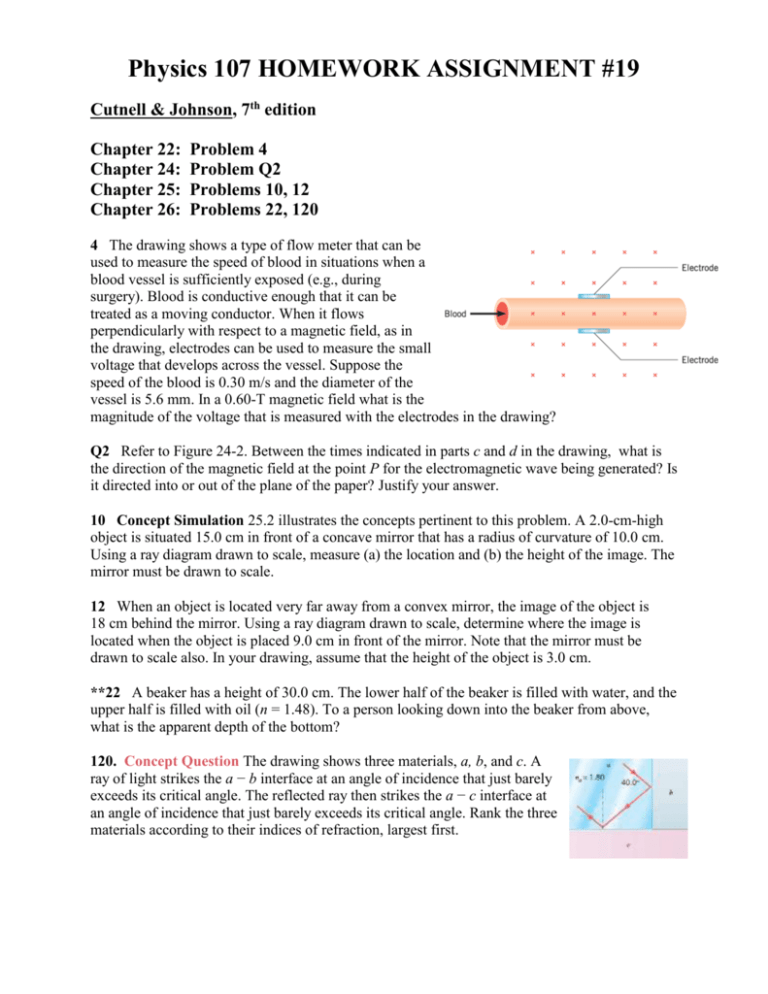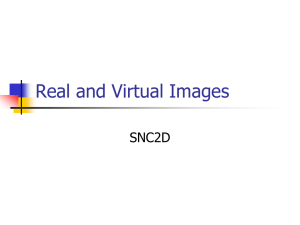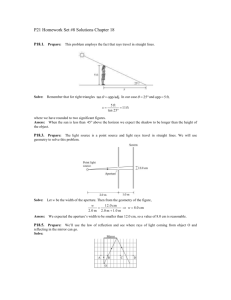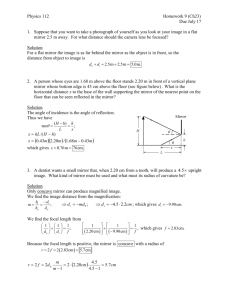hw19
advertisement

Physics 107 HOMEWORK ASSIGNMENT #19 Cutnell & Johnson, 7th edition Chapter 22: Chapter 24: Chapter 25: Chapter 26: Problem 4 Problem Q2 Problems 10, 12 Problems 22, 120 4 The drawing shows a type of flow meter that can be used to measure the speed of blood in situations when a blood vessel is sufficiently exposed (e.g., during surgery). Blood is conductive enough that it can be treated as a moving conductor. When it flows perpendicularly with respect to a magnetic field, as in the drawing, electrodes can be used to measure the small voltage that develops across the vessel. Suppose the speed of the blood is 0.30 m/s and the diameter of the vessel is 5.6 mm. In a 0.60-T magnetic field what is the magnitude of the voltage that is measured with the electrodes in the drawing? Q2 Refer to Figure 24-2. Between the times indicated in parts c and d in the drawing, what is the direction of the magnetic field at the point P for the electromagnetic wave being generated? Is it directed into or out of the plane of the paper? Justify your answer. 10 Concept Simulation 25.2 illustrates the concepts pertinent to this problem. A 2.0-cm-high object is situated 15.0 cm in front of a concave mirror that has a radius of curvature of 10.0 cm. Using a ray diagram drawn to scale, measure (a) the location and (b) the height of the image. The mirror must be drawn to scale. 12 When an object is located very far away from a convex mirror, the image of the object is 18 cm behind the mirror. Using a ray diagram drawn to scale, determine where the image is located when the object is placed 9.0 cm in front of the mirror. Note that the mirror must be drawn to scale also. In your drawing, assume that the height of the object is 3.0 cm. **22 A beaker has a height of 30.0 cm. The lower half of the beaker is filled with water, and the upper half is filled with oil (n = 1.48). To a person looking down into the beaker from above, what is the apparent depth of the bottom? 120. Concept Question The drawing shows three materials, a, b, and c. A ray of light strikes the a − b interface at an angle of incidence that just barely exceeds its critical angle. The reflected ray then strikes the a − c interface at an angle of incidence that just barely exceeds its critical angle. Rank the three materials according to their indices of refraction, largest first. 4. REASONING The situation in the drawing is analogous to that in Figure 22.4b in the text. The blood flowing at a speed v corresponds to the moving rod, and the diameter of the blood vessel corresponds to the length L of the rod in the figure. The magnitude of the magnetic field is B, and the measured voltage is the emf induced by the motion. Thus, we can apply BvL (Equation 22.1). SOLUTION Using Equation 22.1, we find that BvL 0.60 T 0.30 m/s 5.6 103 m 1.0 103 V Q2. REASONING AND SOLUTION Refer to Figure 24.2. Between the times indicated in parts c and d in the drawing, negative charges have moved to the top of the antenna, leaving a net positive charge of equal magnitude on the bottom of the antenna. Therefore, as the negative charges flow, the conventional current points toward the bottom of the antenna Using RHR-2, the magnetic field for the electromagnetic wave at P must point out of the page. 10. REASONING AND SOLUTION The ray diagram is shown in the figure (Note: f = 5.0 cm and do = 15.0 cm). a. The ray diagram indicates that the image distance is 7.5 cm in front of the mirror. b. The image height is 1.0 cm , and the image Object F C Real Image is inverted relative to the object. f di do 12. REASONING When an object is located very far away from a spherical mirror (concave or convex), the image is located at the mirror’s focal point. Here, the image of the distant object is located 18 cm behind the convex mirror, so that the focal length f of the mirror is f = 18 cm and is negative since the mirror is convex. SOLUTION In constructing a ray diagram, we will need to know the radius R of the mirror. 1 2 The focal length of a convex mirror is related to the radius by f R (Equation 25.2). We can use this expression to determine the radius: 1 2 f R or R 2 f 2 18 cm 36 cm In the ray diagram that follows, we denote the focal point by F and the center of curvature by C. Note that the horizontal and vertical distances in this drawing are to scale. This means that the mirror is represented by a circular arc that is also drawn to scale. Note that we have used only rays 1 and 3 in constructing this diagram. Only two of the three rays discussed in the text are needed. 1 3 6.0 cm 18 cm F C From the drawing, we see that the image is located 6.0 cm behind the mirror . 22. REASONING AND SOLUTION The light rays coming from the bottom of the beaker are refracted at two interfaces, the water-oil interface and the oil-air interface. When the rays enter the oil from the water, they appear to have originated from an apparent depth d below the water-oil interface. This apparent depth is given by Equation 26.3 as n 1.48 16.7 cm d d oil (15.0 cm ) 1.33 n water When the rays reach the top of the oil, a distance of 15.0 cm above the water, they can be regarded as having originated from a depth of 15.0 cm + 16.7 cm = 31.7 cm below the oil-air interface. When the rays enter the air, they are refracted again and appear to have come from an apparent depth d below the oil-air interface. This apparent depth is given by Equation 26.3 as n 1.00 21.4 cm d (31.7 cm ) air (31.7 cm ) 1.48 n oil 120. CONCEPT QUESTION Total internal reflection occurs only when light goes from a higher index material toward a lower index material (see Section 26.3). Since total internal reflection occurs at both the a-b and a-c interfaces, the index of refraction of material a is larger than that of either material b or c: na nb and na nc . We now need to determine which index of refraction, nb or nc, is larger. The critical angle is given by Equation 26.4 as sin c = n2/n1, where n2 is the smaller index of refraction. Therefore, the larger the value of n2, the larger the critical angle. It is evident from the drawing that the critical angle for the a-c interface is larger than the critical angle for the a-b interface. Therefore nc must be larger than nb. The ranking of the indices of refraction, largest to smallest, is: na, nc, nb. SOLUTION For the a-b interface, the critical angle is given by Equation 26.4 as sin c = nb/na. Therefore, the index of refraction for material b is nb na sin c 1.80 sin 40.0 1.16 For the a-c interface, we note that the angle of incidence is 90.0 – 40.0 = 50.0. The index of refraction for material c is nc na sin c 1.80 sin 50.0 1.38 As expected, the ranking of the indices of refraction, highest-to-lowest, is na = 1.80, nc = 1.38, nb = 1.16.









